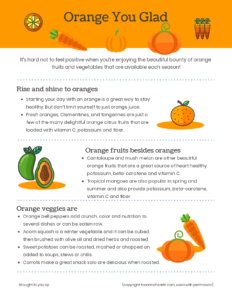Orange you glad?
Orange is the color of summer and fall. It symbolizes joy, sun and the tropics. It’s hard not to feel positive when you’re enjoying the beautiful bounty of orange fruits and vegetables that are available each season!
According to the “color wheel”, orange marries the energy of red, and happiness of yellow. This week’s series features all things orange.
Starting your day with an orange food is a great way to stay healthy. But don’t limit yourself to just orange juice. Fresh oranges, Clementines, and tangerines are just a few of the many delightful orange citrus fruits that are loaded with vitamin C, potassium and fiber. But consumers may want to watch how much time they spend in the sun when they eat citrus. Studies show that citrus fruit contain furocoumarins, a class of photoactive compounds that when combined with UV rays, can induce skin cancer. 1 The study used data from over 56,000 women in the Women’s Health Initiative and found a direct relationship between citrus consumption, sun exposure and risk for cutaneous melanoma. To be safe, be sure to wear sunscreen, which also protects you from wrinkles and premature aging.Cantaloupe and mush melon (popular in the Midwest), are other beautiful orange fruits that are a great source of heart healthy potassium and cancer-fighting beta-carotene and vitamin C. They can be eaten by themselves or topped with low-fat cottage cheese or Greek yogurt to boost protein in your meal. Tropical mangoes are also popular in spring and summer and also provide potassium, beta-carotene, vitamin C and fiber. They’re great to use in smoothies, added to yogurt or processed in a cold, summertime soup.Don’t just limit yourself to orange fruit. Orange vegetables are also highly nutritious and there’s a variety to choose from, especially in the fall months. Orange bell peppers add crunch, color and nutrition to several dishes or can be eaten raw with hummus for a snack. Sautee them and add them to egg dishes, pasta, rice or Mexican cuisine. Orange bell peppers contain more vitamin C than their green counterparts.Acorn squash is a winter vegetable. And while it may be green on the outside, it’s a beautiful bright orange on the inside. Like other squash, it's an excellent source of cancer-fighting beta-carotene and vitamin C and potassium to aid in blood pressure reduction. It’s also a decent source of fiber and folate. Acorn squash can be cubed, then brushed with olive oil and dried herbs and roasted. A one cup serving provides just over 50 calories.Sweet potatoes are another celebrated orange vegetable, but don’t just eat them at the holidays. These versatile gems can be roasted, mashed or chopped an added to soups, stews or chilis. Similar to other orange vegetables, sweet potatoes are high in vitamin C, beta-carotene, potassium and fiber. Try them mashed with grated ginger, orange zest and cinnamon. You’ll never go back to that marshmallow casserole!Finally, don’t forget the humble carrot. Carrots make a great snack solo or with hummus or are often the base of mirepoix in soup when paired with celery and onions. They are delicious when roasted or added to a stew along with potatoes and onions. The beta-carotene in carrots is more bioavailable when cooked, than raw.Reference:
- Melough MM1, Wu S2, Li WQ3, Eaton C4, Nan H5,6, Snetselaar L7, Wallace R7, Qureshi AA3, Chun OK1, Cho E3. Citrus Consumption and Risk of Cutaneous Malignant Melanoma in the Women's Health Initiative. Nutr Cancer.2019 Jul 23:1-8. doi: 10.1080/01635581.2019.1644353. [Epub ahead of print]
Lisa Andrews, MEd, RD, LD Download a printable Orange You Glad PDF handout now that you can print and handout to your clients, employees, students, and patients. Get them eating orange fruits and veggies this week! Go orange![shopify embed_type="collection" shop="nutrition-education-store.myshopify.com" product_handle="rainbow-salad-healthfair-display"][shopify embed_type="collection" shop="nutrition-education-store.myshopify.com" product_handle="20-ways-to-decorate-your-nutrition-education-or-health-wall"]
Download a printable Orange You Glad PDF handout now that you can print and handout to your clients, employees, students, and patients. Get them eating orange fruits and veggies this week! Go orange![shopify embed_type="collection" shop="nutrition-education-store.myshopify.com" product_handle="rainbow-salad-healthfair-display"][shopify embed_type="collection" shop="nutrition-education-store.myshopify.com" product_handle="20-ways-to-decorate-your-nutrition-education-or-health-wall"]
